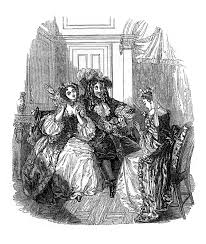
Restoration comedy, a lively and satirical form of theater, flourished in England from 1660 to 1710 after the monarchy was restored following the Puritan-led Commonwealth period. Under Puritan rule, theaters had been closed, and public performances were prohibited due to perceived immorality. With the return of King Charles II, a known theater enthusiast who had spent years in France, the cultural landscape of England underwent a dramatic shift. The King’s influence led to a surge in the theater’s popularity, as well as the introduction of new and innovative styles. Restoration comedy, with its witty dialogue, focused on the exploration of social manners and sexual intrigue.
One of the hallmarks of restoration comedy was its use of stock characters and exaggerated personalities, often representing archetypes like the nobleman and the witty heroine. The plots usually revolve around themes of love, marriage and infidelity, exploring how people navigate these topics in a society that values reputation and wit. Unlike earlier periods that might have focused on moral lessons or romantic ideals, restoration comedies highlighted human flaws and social hypocrisy.
The plays were known for their sparkling wit and elaborate language, filled with double entendres and clever wordplays. Restoration comedies pushed many boundaries by challenging social norms, openly addressing sexuality and personal relationships. Female character, for instance, often displayed more agency and wit than was typical in earlier English theater, though they were confined by societal expectations. Importantly, this period marked the first time women were legally allowed to perform on the English stage, which had a significant impact on theater dynamics. Actresses like Nell Gwyn became famous for their portrayals of strong, witty female characters.
While restoration comedy was immensely popular with audiences, it also faced backlash, especially from moralists who condemned its focus on frivolous themes. This opposition grew strong toward the end of the period, leading a shift away from sharp comedies to more manners of more sentimental morally instructive plays in the early 18th century. Despite this decline, restoration comedy left legacy on English theater and comedy as a genre influencing later playwrights and movements. Its focus on wit, social commentary, and character relationships can still be found in modern comedies of manners and satires, making restoration comedy a foundational movement in the history of English drama.
Sources:
https://www.newworldencyclopedia.org/entry/Restoration_Comedy
https://fiveable.me/key-terms/art-and-literature/restoration-comedy
Add comment
Comments